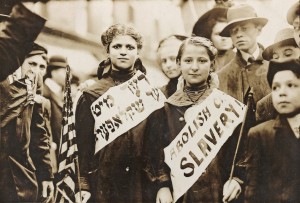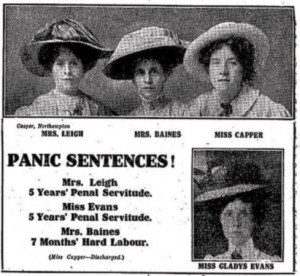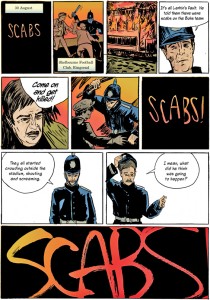
Striking Times
By Eric Hillis
By the time the Dublin Lock-Out took place in 1913, workers downing tools in protest had become a growing global phenomenon.
With the United States experiencing industrial growth on an unprecedented scale, it became the site of several of the bloodiest disputes of the early twentieth century.
In May 1900, tram workers in St. Louis went on strike, attacking their temporary replacements. The police swore in 2,500 civilians and armed them, in order to guard the streetcars. Gunfights broke out along the tram-lines. By the end of the dispute in September, 14 people had been killed and over 200 wounded. None of the workers’ demands were met.
Two years later, in the coal-fields of Pennsylvania, the United Mine Workers of America downed tools, demanding their union receive official recognition. With America’s cities facing a winter without coal, President Theodore Roosevelt was forced to intervene and eventually met the miners’ demands.
When Union leaders called off a 1905 strike in Chicago that had resulted in many casualties, it was revealed they had accepted bribes to do so, a revelation which lead to widespread mistrust of America’s Unions amongst the nation’s workers.
Anti-semitism was rife during this period, often translating to lower wages and poor conditions. In 1909, Jewish women employed in New York’s garment industry, pictured above, struck a blow for both their religion and gender when a successful strike led to better pay and shorter hours. It was the first female uprising in the U.S to yield positive results.
Slovak immigrants who went on strike in the Pennsylvania coal mines during 1910 weren’t so successful. Thousands of miners’ families were evicted from their homes, which were owned by the coal company, and relocated to a ‘tent city’ organised by the United Mine Workers of America. A private police force, known as the Coal and Iron Police, were drafted in to guard the strike-breakers working in the mines. 16 strikers died at the hands of this police force. In July of 1911, 14 months after the strike had commenced, the miners went back to work, defeated by the prospect of spending another winter living inside ramshackle tents.
Today, most adults would baulk at the prospect of a 56-hour week, but this was the reality for the workforce of the Lawrence, Massachusetts textile mills of 1912. When the weekly wage of $9, was reduced, 20,000 workers went on strike. The heavy-handed tactics of the police, which caused one striking woman to suffer a miscarriage, made news around the world. Workers as far away as France and Sweden refused to load U.S-bound ships, in support of the Lawrence workers, the first strike to receive global attention.
Spurred on by the widespread sympathy the Lawrence strikers had received, Unions around the world became more confident and the following years saw workers take action in cities like Brisbane, Wellington, and, of course, Dublin.

Why the Lock-Out happened
By Joan Mitchell
One hundred years ago, Britain and Ireland were going through huge changes. In 1910-1911 there was a Welsh coal miner’s strike with 12,000 men marching in the Rhondda Valley. Police were sent from London and Lancashire to deal with the social unrest and finally Winston Churchill sent in the British Army to stop the rioting.
The following year, there was a National Coal Strike in England, with thousands demanding a clear pay structure for their work and again the army were called in. In Parliament the Minimum Wage Act passed, as demanded by the Unions.
While the National Coal strike was going on, The Suffragettes, above right, were breaking windows in the West End of London and demanding the vote for women. In April 1912 just as the strike was ending, the Titanic sank and sent shockwaves all over Britain and Ireland. There was a feeling that times were changing, social class was beginning to crumble and people felt they were on the crest of a wave – they could make change happen.
In Dublin, we had the worst living conditions in Western Europe, with TB rampant and child death all too common – life was extremely hard. In the dockyard, men and boys turned up at the docks each day not sure if they could earn a day’s pay. The foreman picked those he favoured or the strongest and his choice could determine if your family ate that day.
With so much change happening against a background for Home Rule in Dublin (100,000 marching), there was a tangible appetite for change, and in walked Big Jim Larkin who said, “We are now on the threshold of a newer movement, with a newer hope and a new inspiration.”
The people were at breaking point and they were willing to do whatever it took. There were more slums in Dublin in 1913 than in Calcutta; families were living in one-room tenements, with one tap and one toilet in the yard for up to 80 people.
Workers who joined the newly-formed union were ‘locked out’ from their jobs unless they signed a pledge to denounce it. When they wouldn’t sign the pledge, non-union workers were given their jobs. ‘The Lock-Out’ phrase was born.
On August 30th there were riots in Ringsend, Beresford Place and Eden Quay and police baton charged the crowd. Two men were hit on the head with batons and later died from fractured skulls.
Throughout the Lock-Out, food parcels for children arrived from the trade union TUC in England and without their aid (food and financial) the strikers would not have been able to survive. The strike lasted seven months and Larkin was portrayed as the villain by the wealthy industrialist William Martin Murphy, who owned the Irish Independent, Sunday Independent and Evening Herald, Dublin Tramway, Clearys and The Imperial Hotel. Throughout the Lock-Out, the Catholic Church supported the employers, as they feared Larkin and his popular socialism.

Riots in Ringsend
By Liam Cahill
It was supposed to be a friendly football match between two rival teams – Shelbourne vs Bohemians – to mark the opening of Shelbourne’s new stadium but what resulted on Saturday August 30th 1913, was a riot which became one of the pivotal moments of the 1913 Lock-Out.
The spark for the riots which took place in Ringsend is very much up for interpretation. Many people blamed it on Jim Larkin, the head of the Irish Transport and General Workers’ Union who was engaged in a vicious dispute with William Martin Murphy the press Baron and over 300 employers on workers’ rights.
Author of the book Lockout Arnold Wrights said that Larkin called members of the teams “scabs” (referring to scab labour) and said the only reason anyone would be at the match was to picket for his Union’s demands. The result was a massive riot between 6,000 spectators and 100 tramway men. It is unsure why the tramway men had gathered outside the grounds on that particular day to picket, but many believe they were under instruction from Larkin to do so. A number of trams carrying supporters to the match were attacked.
In the weeks before the game, the political atmosphere had intensified between Larkin and Murphy.The Lock-Out had been ongoing for weeks with no end in sight. The vitriol of these disputes may have created intensity at the football game.
In the end, the police brought the riots to a close by “forcibly closing” pubs in and around Ringsend and making a total of 16 arrests, with over 50 people treated in hospital for injuries.

